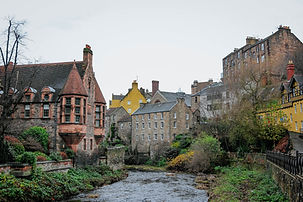
Journey about the mills
The silent witnesses
The historic mills alongside the Water of Leith stand as silent witnesses to the river's industrial legacy. Once bustling centers of production, these mills took advantage of the River's power for milling grains, spinning wool, and various manufacturing processes. Today, remnants of these structures, like the quaint Dean Village Mill, blend seamlessly into the urban landscape, offering a nostalgic glimpse into Edinburgh's industrial past. Beyond their architectural significance, these mills contribute to the cultural fabric of the region, telling tales of labor, innovation, and the symbiotic relationship between waterways and industrial progress. Preserving the legacy of Water of Leith's mills adds a touch of heritage to the modern cityscape, honoring the dynamic history that has shaped this city.

Mills in Edinburgh, 1900-1906 (Calton, N. & Fleet, C., 2021)
Ever Working Wheel

You can explore the mills along the Water of Leith as well as those scattered throughout Scotland using this map (https://maps.nls.uk/projects/mills/). Find the one nearest to your home or interest to you and plan a visit. Take a walk along the River and see if you can spot any ruins or old buildings that could be evidence of a mill. Take photos or notes to document your findings. Try reading "The Water Mills of the Water of Leith" by Graham Priestley or visiting the library if you would like to learn more about their history. Even though the mills have faded out of our society, their contribution to this city's development is invaluable. Also, you might want to speak to seniors who have lived in the city for decades, sometimes they might tell you more than the book can!
In Victorian and industrial times, mills along the Water of Leith in Edinburgh discharged pollutants into the River, leaving an environmental legacy that carried into the 20th century. Effluents from textile and industrial processes introduced contaminants, affecting water quality and aquatic ecosystems. Discharges that contain chemicals and dyes threatened fish and other aquatic life. To address this issue, a series of measures are implemented to reduce pollution, including pollution control measures. With the mills closing, the pollution problem from mills is now over. However, the River is still affected by both point source and diffuse pollution, particularly during low flow periods. Runoff from various sources, including farmland, roads, residential and commercial areas, accumulates in the catchment and threatens the aquatic system. There is also a possibility that rubbish along the walkway could be washed into the River, further contaminating it. Understanding this pollution underscores the significance of conservation measures, ensuring the River's ecological health and resilience against the influence of its industrial past and contemporary human activities.
When you visit the River, you can always help by picking up litter along the way. You can also volunteer to support local organizations that protect the River's health. Do not underestimate the importance of your role in conserving the River and its surroundings. Besides giving animals and vegetation a better habitat, you can also enjoy a more pleasant environment. By doing your part, you can ensure that the River continues to thrive and provide valuable resources for generations to come.

